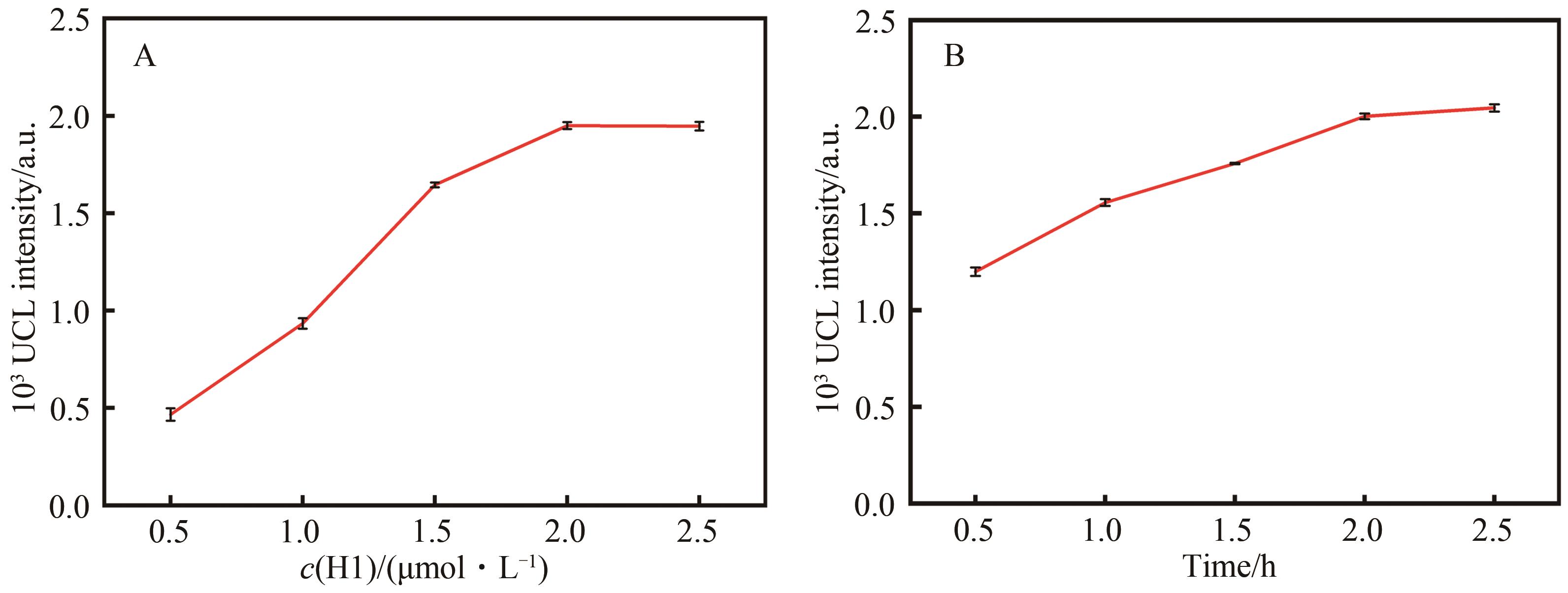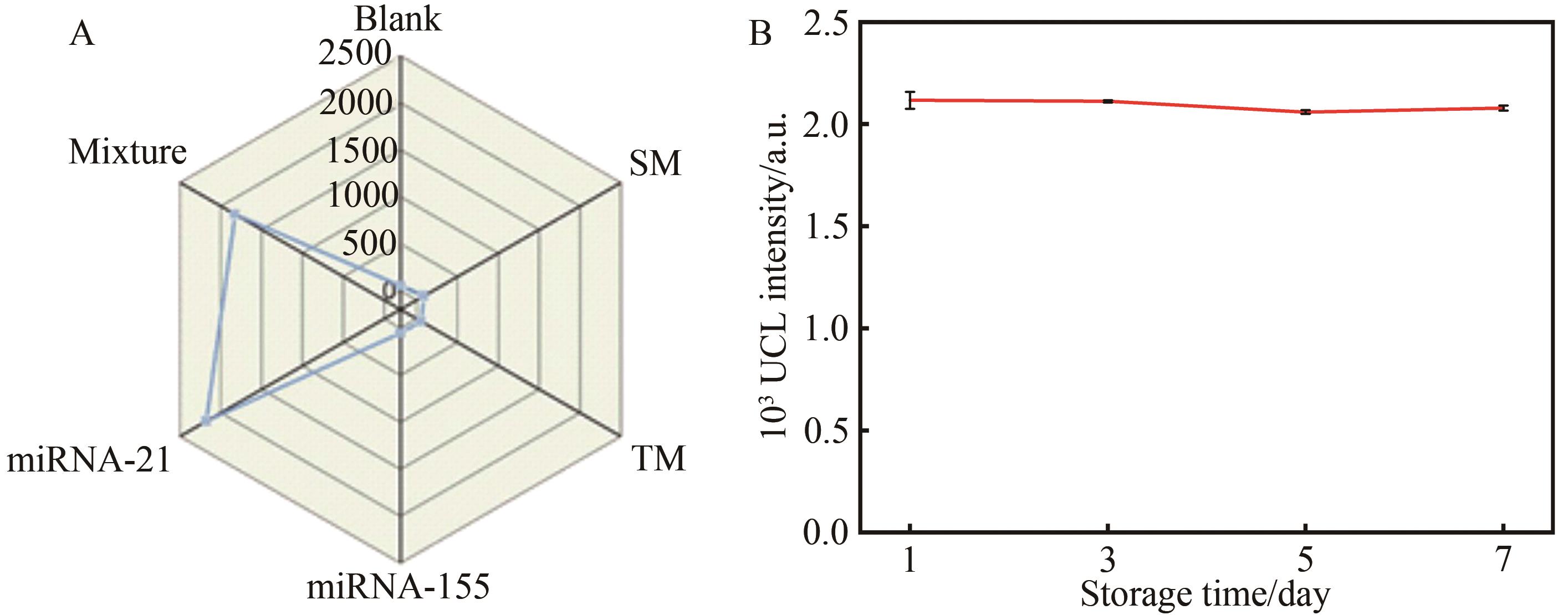
应用化学 ›› 2024, Vol. 41 ›› Issue (1): 137-146.DOI: 10.19894/j.issn.1000-0518.230083
基于上转换信标探针构建信号放大近红外激发荧光生物传感器用于microRNA检测
周学敏1, 吕姝臻2, 张国芳1, 崔竹梅1( ), 毕赛2(
), 毕赛2( )
)
- 1.青岛大学附属医院,青岛 266061
2.青岛大学化学化工学院,青岛 266071
-
收稿日期:2023-03-31接受日期:2023-05-31出版日期:2024-01-01发布日期:2024-01-30 -
通讯作者:崔竹梅,毕赛 -
基金资助:北京康华中西医发展基金会项目(KH-2021-LLZX-014);国家自然科学基金(22076087);山东省杰出青年基金(ZR2020JQ08)
A Near-Infrared-Driven Signal Amplification Fluorescence Biosensor Based on Upconversion Beacon Probe for microRNA Detection
Xue-Min ZHOU1, Shu-Zhen LYU2, Guo-Fang ZHANG1, Zhu-Mei CUI1( ), Sai BI2(
), Sai BI2( )
)
- 1.The Affiliated Hospital of Qingdao University,Qingdao 266061,China
2.College of Chemistry and Chemical Engineering,Qingdao University,Qingdao 266071,China
-
Received:2023-03-31Accepted:2023-05-31Published:2024-01-01Online:2024-01-30 -
Contact:Zhu-Mei CUI,Sai BI -
About author:bisai11@126.com
cuizhumei1966@126.com
-
Supported by:the Beijing Kanghua Foundation for the Development of Traditional Chinese and Western Medicine(KH-2021-LLZX-014);the National Natural Science Foundation of China(22076087);the Natural Science Fund for Distinguished Young Scholars of Shandong Province(ZR2020JQ08)
摘要:
基于NaYF4∶Yb3+,Tm3+@NaYF4上转换纳米颗粒(Upconversion nanoparticles, UCNPs)和DNA催化发夹组装(Catalytic hairpin reaction, CHA)技术构建近红外激发(Near-infrared, NIR)荧光生物传感器,用于microRNA的高灵敏分析。靶标microRNA-21(miRNA-21)可与磁珠(Magnetic beads, MBs)表面修饰的发夹H1发生toehold区域介导的链取代反应,发夹H1暴露新的toehold区域与UCNPs表面修饰的发夹H2发生反应,形成H1/H2复合物,同时miRNA-21被取代并与新的发夹H1反应,此过程将UCNPs固定于MBs表面,而且实现了信号的循环放大。接下来通过磁分离技术,将固定于MBs表面的UCNPs分离出来,在808 nm NIR的激发下产生上转换发光(Upconversion luminescence, UCL),对miRNA-21的检测范围为0.1~100 nmol/L,检出限为11.3 pmol/L。此外,该荧光生物传感器成功应用于血清样本中miRNA-21的分析,表明其具有良好的实用性。
中图分类号:
引用本文
周学敏, 吕姝臻, 张国芳, 崔竹梅, 毕赛. 基于上转换信标探针构建信号放大近红外激发荧光生物传感器用于microRNA检测[J]. 应用化学, 2024, 41(1): 137-146.
Xue-Min ZHOU, Shu-Zhen LYU, Guo-Fang ZHANG, Zhu-Mei CUI, Sai BI. A Near-Infrared-Driven Signal Amplification Fluorescence Biosensor Based on Upconversion Beacon Probe for microRNA Detection[J]. Chinese Journal of Applied Chemistry, 2024, 41(1): 137-146.
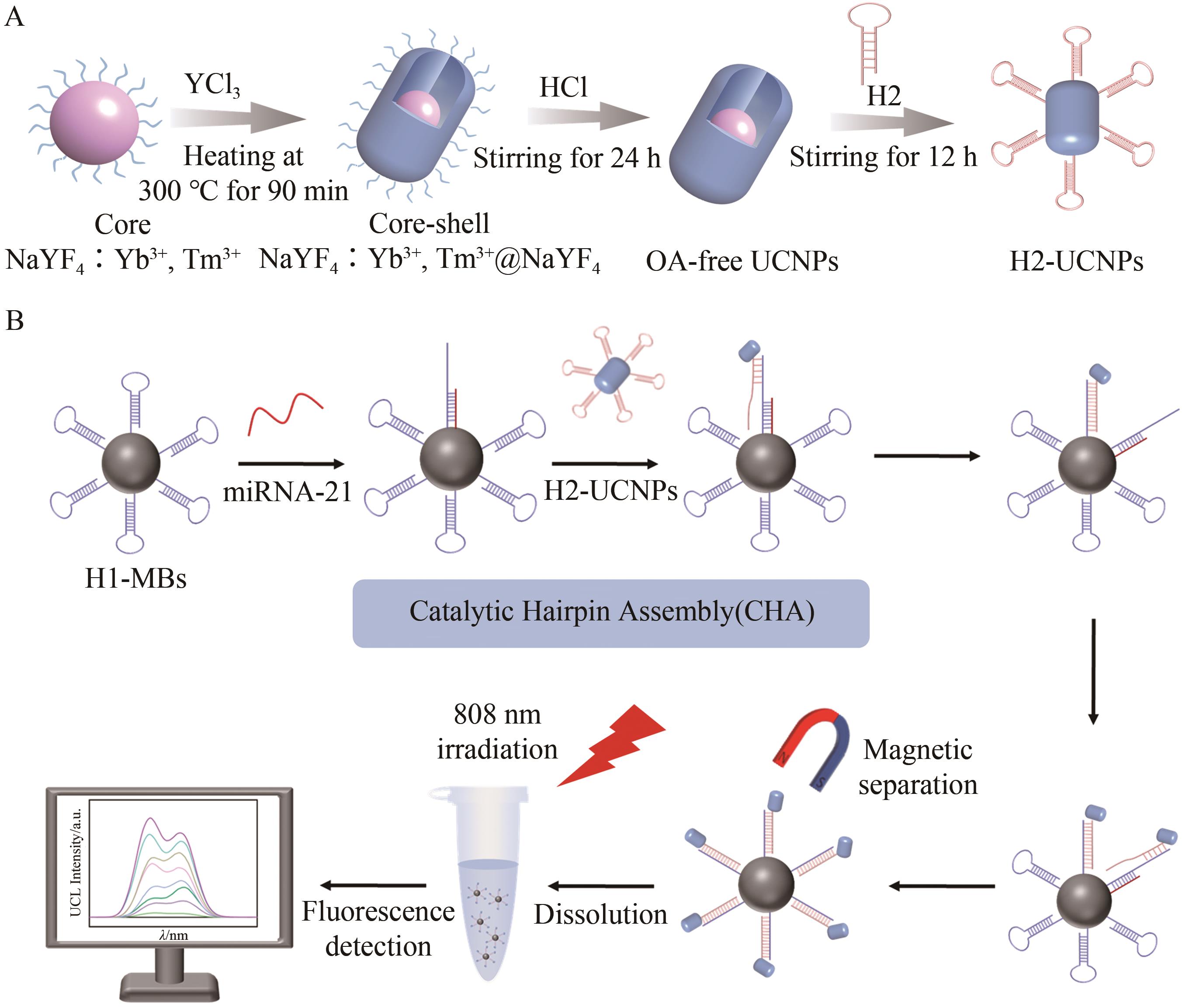
图1 基于UCNPs和CHA信号放大策略的荧光生物感器检测miRNA-21示意图
Fig.1 Schematic of fluorescence biosensor based on UCNPs and CHA amplification strategy for the detection of miRNA-21
| Name | Sequence(5'-3') |
|---|---|
| miRNA-21 | UAG CUU AUC AGA CUG AUG UUG A |
| miRNA-155 | UUA AUG CUA AUC GUG AUA GGG GU |
| H1 | AGA CTG ATG TTG ACT TAG CTT ATC GAT CAA CAT CAG TCT GAT AAG CTA-NH2 |
| H2 | ACT TAG CTT ATC AGA CTG ATG TTG ATC GAT AAG CTA AGT CAA CTA CA |
| Single-base mismatched miRNA-21 | UA |
| Three-base mismatched miRNA-21 | UA |
表 1 工作中用到的核苷酸序列
Table 1 Sequences of oligonucleotides used in this study
| Name | Sequence(5'-3') |
|---|---|
| miRNA-21 | UAG CUU AUC AGA CUG AUG UUG A |
| miRNA-155 | UUA AUG CUA AUC GUG AUA GGG GU |
| H1 | AGA CTG ATG TTG ACT TAG CTT ATC GAT CAA CAT CAG TCT GAT AAG CTA-NH2 |
| H2 | ACT TAG CTT ATC AGA CTG ATG TTG ATC GAT AAG CTA AGT CAA CTA CA |
| Single-base mismatched miRNA-21 | UA |
| Three-base mismatched miRNA-21 | UA |
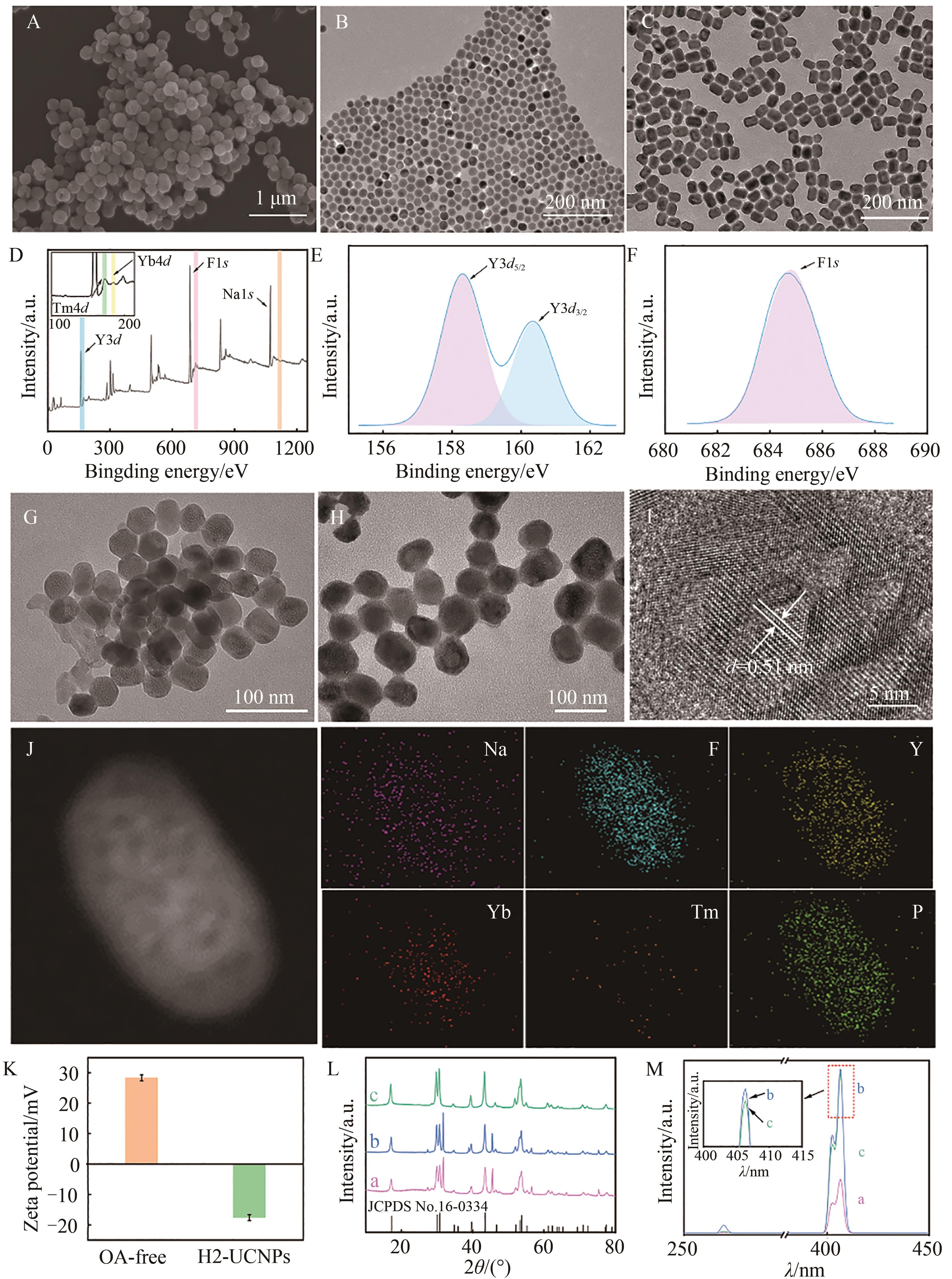
图2 (A)MBs的SEM图。 (B)NaYF4∶Yb3+,Tm3+ UCNPs和(C)NaYF4∶Yb3+,Tm3+@NaYF4 UCNPs的TEM图。(D) NaYF4∶Yb3+,Tm3+@NaYF4 UCNPs的XPS表征。 (E) Y3d和(F)F1s轨道的高分辨XPS图谱。 (G)去除OA的UCNPs和(H) H2-UCNPs的TEM图。H2-UCNPs的(I)HRTEM和(J)EDS表征。(K)去除OA的 UCNPs和H2-UCNP的Zeta电位表征。 (L) NaYF4∶Yb3+,Tm3+ UCNPs(a)、NaYF4∶Yb3+,Tm3+@NaYF4 UCNPs(b)和H2-UCNPs(c)的XRD表征。 (M) 808 nm NIR激发下NaYF4∶Yb3+,Tm3+ UCNPs(a)、NaYF4∶Yb3+,Tm3+@NaYF4 UCNPs(b)和H2-UCNPs(c)的UCL光谱
Fig.2 (A) SEM image of MBs. TEM images of (B) NaYF4∶Yb3+,Tm3+ UCNPs and (C) NaYF4∶Yb3+,Tm3+@NaYF4 UCNPs. (D) XPS survey spectrum of NaYF4∶Yb3+,Tm3+@NaYF4 UCNPs. High-resolution XPS spectra of (E) Y3d and (F) F1s. TEM images of (G) OA-free UCNPs and (H) H2-UCNPs. (I) HRTEM and (J) EDS elemental mapping of H2-UCNPs. (K) Zeta potential of OA-free UCNPs and H2-UCNPs. (L) XRD spectrum of NaYF4∶Yb3+,Tm3+ UCNPs (a), NaYF4∶Yb3+,Tm3+@NaYF4 UCNPs (b) and H2-UCNPs (c). (M) UCL spectra of NaYF4∶Yb3+,Tm3+ UCNPs (a), NaYF4∶Yb3+,Tm3+@NaYF4 UCNPs (b) and H2-UCNPs (c) under 808 nm NIR
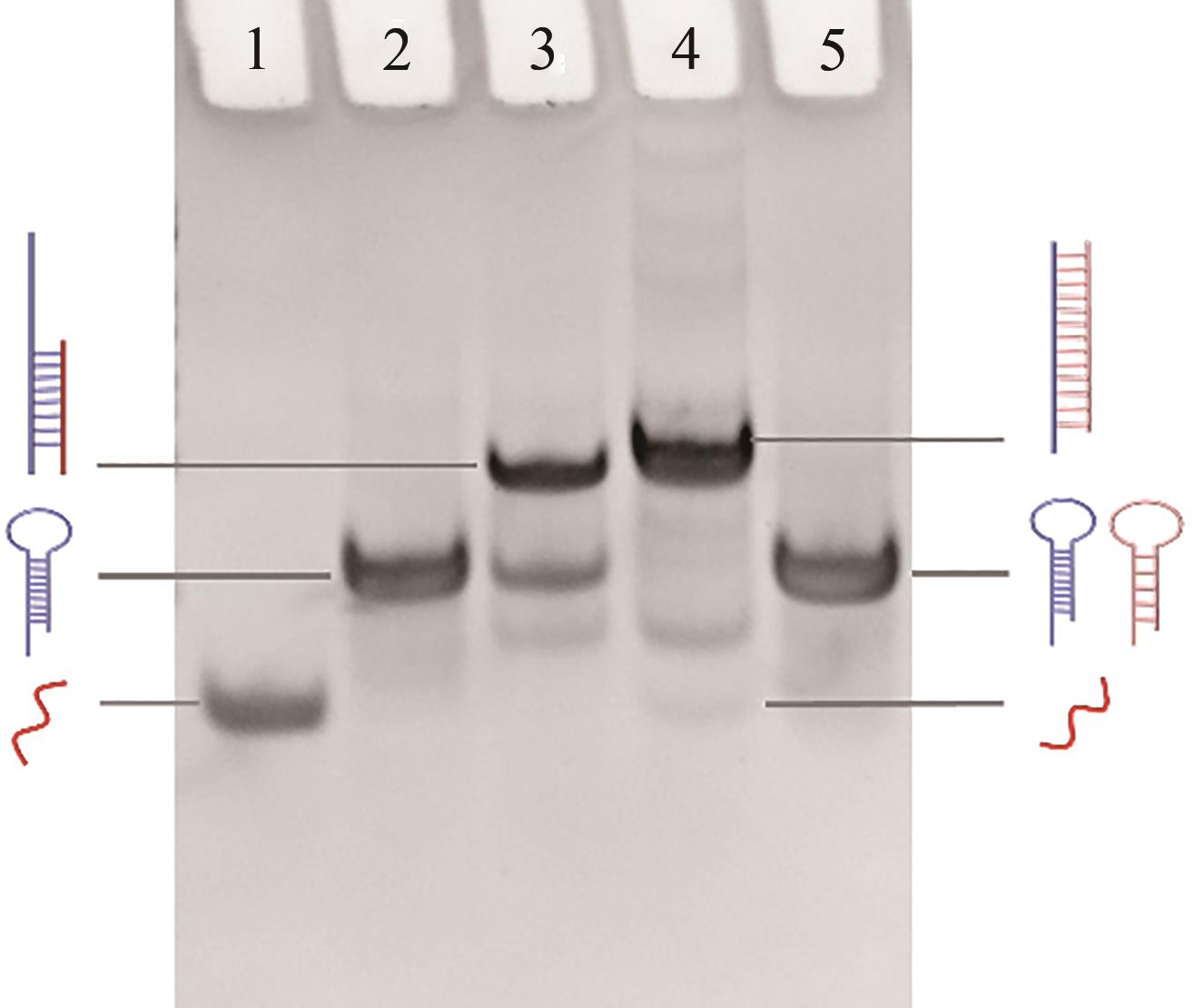
图3 非变性聚丙烯凝胶电泳表征CHA反应过程。泳道1: miRNA-21; 泳道2: H1; 泳道3: miRNA-21+H1; 泳道4: miRNA-21+H1+H2; 泳道5: H1+H2
Fig.3 Native PAGE for the characterization of CHA process. Lane 1: miRNA-21; lane 2: H1; lane 3: miRNA-21+H1; lane 4:miRNA-21+H1+H2; lane 5: H1+H2

图5 (A)采用所构建的近红外荧光生物传感检测不同浓度miRNA-21的UCL光谱。 (B) UCL强度与miRNA-21浓度对数的线性关系图
Fig.5 (A) UCL spectra toward miRNA-21 with different concentrations using the proposed NIR fluorescence biosensor. (B) Corresponding linear relationship between UCL intensity and logarithm of miRNA-21 concentration
| Methods | Linear range/(nmol·L-1) | Detection limit/(pmol·L-1) | Ref. |
|---|---|---|---|
| Fluorescence | 0.1~16 | 93.8 | [ |
| Fluorescence | 0.5~150 | 83.0 | [ |
| Fluorescence | 0.1~300 | 67.0 | [ |
| Fluorescence | 2.5~80 | 250.0 | [ |
| Electrochemistry | 0.1~104 | 83.0 | [ |
| Fluorescence | 0.1~100 | 11.3 | This work |
表2 不同传感体系的检测性能比较
Table 2 Comparison of performance of different sensing system
| Methods | Linear range/(nmol·L-1) | Detection limit/(pmol·L-1) | Ref. |
|---|---|---|---|
| Fluorescence | 0.1~16 | 93.8 | [ |
| Fluorescence | 0.5~150 | 83.0 | [ |
| Fluorescence | 0.1~300 | 67.0 | [ |
| Fluorescence | 2.5~80 | 250.0 | [ |
| Electrochemistry | 0.1~104 | 83.0 | [ |
| Fluorescence | 0.1~100 | 11.3 | This work |
| Num | Added/(nmol·L-1) | Measured value/(nmol·L-1) | RSD/%(n=3) | Recovery/% |
|---|---|---|---|---|
| 1 | 0 | 0.06 | 0.55 | - |
| 2 | 0.7 | 0.72 | 0.84 | 103.41 |
| 3 | 7 | 7.13 | 0.41 | 101.86 |
| 4 | 70 | 70.79 | 1.02 | 101.14 |
表 3 采用所构建的近红外荧光传感器检测血清中miRNA-21
Table 3 Detection of miRNA-21 in human serum by NIR-driven fluorescence biosensor
| Num | Added/(nmol·L-1) | Measured value/(nmol·L-1) | RSD/%(n=3) | Recovery/% |
|---|---|---|---|---|
| 1 | 0 | 0.06 | 0.55 | - |
| 2 | 0.7 | 0.72 | 0.84 | 103.41 |
| 3 | 7 | 7.13 | 0.41 | 101.86 |
| 4 | 70 | 70.79 | 1.02 | 101.14 |
| 1 | ALI SYDA Z, LANGDEN S, MUNKHZUL C, et al. Regulatory mechanism of microRNA expression in cancer[J]. Int J Mol Sci, 2020, 21(5): 1723. |
| 2 | 牛亚倩, 刘芳, 陈彻. 纳米生物传感器在肿瘤microRNA-21检测中的应用[J]. 中国生物制品学杂志, 2022, 35(6): 759-762. |
| NIU Y Q, LIU F, CHEN C. Application of nano-biosensors in detection of tumor microRNA-21[J]. Chin J Biol, 2022, 35(6): 759-762 | |
| 3 | LI F, ZHOU Y, YIN H, et al. Recent advances on signal amplification strategies in photoelectrochemical sensing of microRNAs[J]. Biosens Bioelectron, 2020, 166: 112476. |
| 4 | VÁRALLYAY E, BURGYÁN J, HAVELDA Z. MicroRNA detection by northern blotting using locked nucleic acid probes[J]. Nat Protoc, 2008, 3(2): 190-196. |
| 5 | SONG Y, XU Z, WANG F. Genetically encoded reporter genes for microRNA imaging in living cells and animals[J]. Mol Ther Nucleic Acids. 2020, 21: 555-567. |
| 6 | PETRICA L, PUSZTAI A M, VLAD M, et al. MiRNA expression is associated with clinical variables related to vascular remodeling in the kidney and the brain in type 2 diabetes mellitus patients[J]. Endocr Res, 2020, 45(2): 119-130. |
| 7 | MEIS J E, KHANNA A. RNA amplification and cDNA synthesis for qRT-PCR directly from a single cell[J]. Nat Methods, 2009(6): an12-an13. |
| 8 | 于绍楠, 任玲玲, 任立群, 等. 基于上转换纳米粒子-金纳米棒的荧光共振能量转移免疫分析法用于癌胚抗原检测[J]. 分析化学, 2022, 50(9): 1299-1307. |
| YU S N, REN L L, REN L Q, et al. Upconversion nanoparticles/gold nanorods-based fluorescence resonance energy transfer immunoassay for detection of carcinoembryonic antigen[J]. Chin J Anal Chem, 2022, 50(9): 1299-1307. | |
| 9 | HU Q, DUAN C, WU J, et al. Colorimetric and ratiometric chemosensor for visual detection of gaseous phosgene based on anthracene carboxyimide membrane[J]. Anal Chem, 2018, 90(14): 8686-8691. |
| 10 | GUTIÉRREZ-G LVEZ L, GARCÍA-MENDIOLA T, GUTIÉRREZ-SÁNCHEZ C, et al. Carbon nanodot-based electrogenerated chemiluminescence biosensor for miRNA-21 detection[J]. Mikrochim Acta, 2021, 188(11): 398. |
| 11 | LIU S T, CHEN J S, LIU X P, et al. A photoelectrochemical biosensor based on b-TiO2/CdS∶Eu/Ti3C2 heterojunction for the ultrasensitive detection of miRNA-21[J]. Talanta, 2023, 253: 123601. |
| 12 | YANG Z, GUO Y, ZHOU J, et al. Ultrasensitive fluorescence detection and imaging of microRNA in cells based on a hyperbranched RCA-assisted multiposition SDR signal amplification strategy[J]. Anal Chem, 2022, 94(46): 16237-16245. |
| 13 | ZHANG J, BAO X, ZHOU J, et al. A mitochondria-targeted turn-on fluorescent probe for the detection of glutathione in living cells[J]. Biosens Bioelectron, 2016, 85: 164-170. |
| 14 | ZHAO M, CHEN A Y, HUANG D, et al. MoS2 quantum dots as new electrochemiluminescence emitters for ultrasensitive bioanalysis of lipopolysaccharide[J]. Anal Chem, 2017, 89(16): 8335-8342. |
| 15 | HIMMELSTOß S F, HIRSCH T. A critical comparison of lanthanide based upconversion nanoparticles to fluorescent proteins, semiconductor quantum dots, and carbon dots for use in optical sensing and imaging[J]. Methods Appl Fluoresc, 2019, 7(2): 022002. |
| 16 | ZHU Q Y, LI H, XU D K. Sensitive and enzyme-free fluorescence polarization detection for miRNA-21 based on decahedral sliver nanoparticles and strand displacement reaction[J]. RSC Adv, 2020, 10(29): 17037-17044. |
| 17 | ZHAN Y, ZHANG R, GUO Y, et al. Recent advances in tumor biomarker detection by lanthanide upconversion nanoparticles[J]. J Mater Chem B, 2023, 11(4): 755-771. |
| 18 | SHAO K, XIE W, LING Q, et al. Dumbbell-like upconversion nanoparticles synthesized by controlled epitaxial growth for light-heat-color tri-modal sensing of carcinoembryonic antigen[J]. Biosens Bioelectron, 2023, 228: 115186. |
| 19 | LIU Y, ZHAN S, SU X, et al. An optical strategy for detecting hypochlorite in vitro and cells with high selectivity and stability based on a lanthanide-doped upconversion probe[J]. RSC Adv, 2022, 12(49): 31608-31616. |
| 20 | RONG Y, HASSAN M M, OUYANG Q, et al. Ratiometric upconversion fluorometric turn-off nanosensor for quantification of furfural in foods[J]. Sens Actuators B: Chem, 2022(350): 130843. |
| 21 | 龙禹同, 万里, 赵国杰. 催化发夹自组装技术用于miRNA检测的研究进展[J]. 生命科学研究, 2023, 27(1): 86-94. |
| LONG Y T, WAN L, ZHAO G J. Research progress of catalytic hairpin assembly technique for miRNA detection[J]. Life Sci Res, 2023, 27(1): 86-94. | |
| 22 | LIU J, ZHANG Y, XIE H, et al. Applications of catalytic hairpin assembly reaction in biosensing[J]. Small, 2019, 15(42): e1902989. |
| 23 | SHEN J, LI T, WANG M, et al. Isothermal and enzyme-free microRNA assay based on catalytic hairpin assembly and rare earth element labeled probes[J]. Sens Actuators B: Chem, 2022, 357: 131364. |
| 24 | WANG Y X, WANG D X, WANG J, et al. DNA nanolantern-mediated catalytic hairpin assembly nanoamplifiers for simultaneous detection of multiple microRNAs[J]. Talanta, 2022, 236: 122846. |
| 25 | ZHANG X L, YIN Y, DU S M, et al. Dual 3D DNA nanomachine-mediated catalytic hairpin assembly for ultrasensitive detection of microRNA[J]. Anal Chem, 2021, 93(41): 13952-13959. |
| 26 | ZHANG Y, ZHANG X, SITU B, et al. Rapid electrochemical biosensor for sensitive profiling of exosomal microRNA based on multifunctional DNA tetrahedron assisted catalytic hairpin assembly[J]. Biosens Bioelectron, 2021, 183: 113205. |
| 27 | KOSTIV U, FARKA Z, MICKERT M J, et al. Versatile bioconjugation strategies of PEG-modified upconversion nanoparticles for bioanalytical applications[J]. Biomacromolecules, 2020, 21(11): 4502-4513. |
| 28 | LIU L, HUA R, ZHANG X, et al. Spectral identification and detection of curcumin based on lanthanide upconversion nanoparticles[J]. Appl Surf Sci, 2020, 525: 146566. |
| 29 | LUO Z, ZHANG L, ZENG R, et al. Near-infrared light-excited core-core-shell UCNP@Au@CdS upconversion nanospheres for ultrasensitive photoelectrochemical enzyme immunoassay[J]. Anal Chem, 2018, 90(15): 9568-9575. |
| 30 | YAO C, TANG J, ZHU C, et al. A signal processor made from DNA assembly and upconversion nanoparticle for pharmacokinetic study[J]. Nano Today, 2022, 42: 101352. |
| 31 | YAO S, XIANG L, WANG L, et al. pH-responsive DNA hydrogels with ratiometric fluorescence for accurate detection of miRNA-21[J]. Anal Chim Acta, 2022, 1207: 339795. |
| 32 | ZHAO X, WANG S, ZOU R, et al. An enzyme-free probe based on G-triplex assisted by silver nanocluster pairs for sensitive detection of microRNA-21[J]. Mikrochim Acta, 2021, 188(2): 55. |
| 33 | LU X, LI D, LUO Z, et al. A dual-functional fluorescent biosensor based on enzyme-involved catalytic hairpin assembly for the detection of APE1 and miRNA-21[J]. Analyst, 2022, 147(12): 2834-2842. |
| 34 | KONG L Y, LV S Z, QIAO Z J, et al. Metal-organic framework nanoreactor-based electrochemical biosensor coupled with three-dimensional DNA walker for label-free detection of microRNA[J]. Biosens Bioelectron, 2022, 207: 114188. |
| [1] | 徐昕, 李烨, 王敏, 傅章程, 齐国敏, 卢春华. 基于microRNA‑21响应的Zn2+/DNA自组装体用于肿瘤的检测和氧化应激治疗[J]. 应用化学, 2024, 41(1): 164-174. |
| [2] | 李伟佳, 马志方, 辛志荣, 石强. 二维层状钴铁双氢氧化物用于癌症协同光治疗[J]. 应用化学, 2020, 37(6): 627-634. |
| [3] | 刘金彦, 廖永娟. 季铵盐二聚表面活性剂C12-S2-C12·2Br复配体系在氯仿中形成反胶团的增溶水状态[J]. 应用化学, 2013, 30(07): 846-851. |
| [4] | 崔晓君, 袁昌明, 徐立恒. 花生油中过氧化物的近红外光谱分析[J]. 应用化学, 2008, 25(3): 375-377. |
| [5] | 高俊, 徐建强, 高桂枝, 徐永业, 陈苏敏. 近红外光谱测定聚四氢呋喃混合液[J]. 应用化学, 2008, 25(12): 1435-1438. |
| [6] | 孟庆繁, 候欣彤, 魏广英, 逯家辉, 郭伟良, 滕利荣. 近红外光谱无损定量分析吡嗪酰胺片[J]. 应用化学, 2007, 24(10): 1153-1156. |
| [7] | 高俊, 徐永业, 姚成. 近红外光谱法测定汽油中的烯烃含量[J]. 应用化学, 2005, 22(12): 1390-1392. |
| 阅读次数 | ||||||
|
全文 |
|
|||||
|
摘要 |
|
|||||
